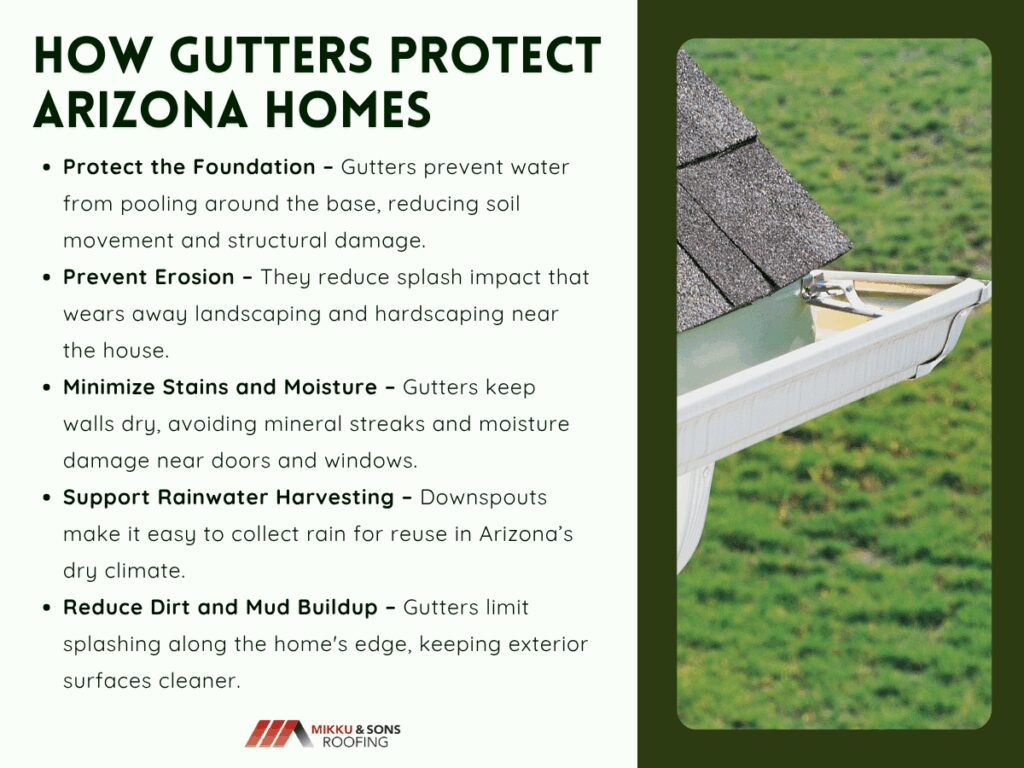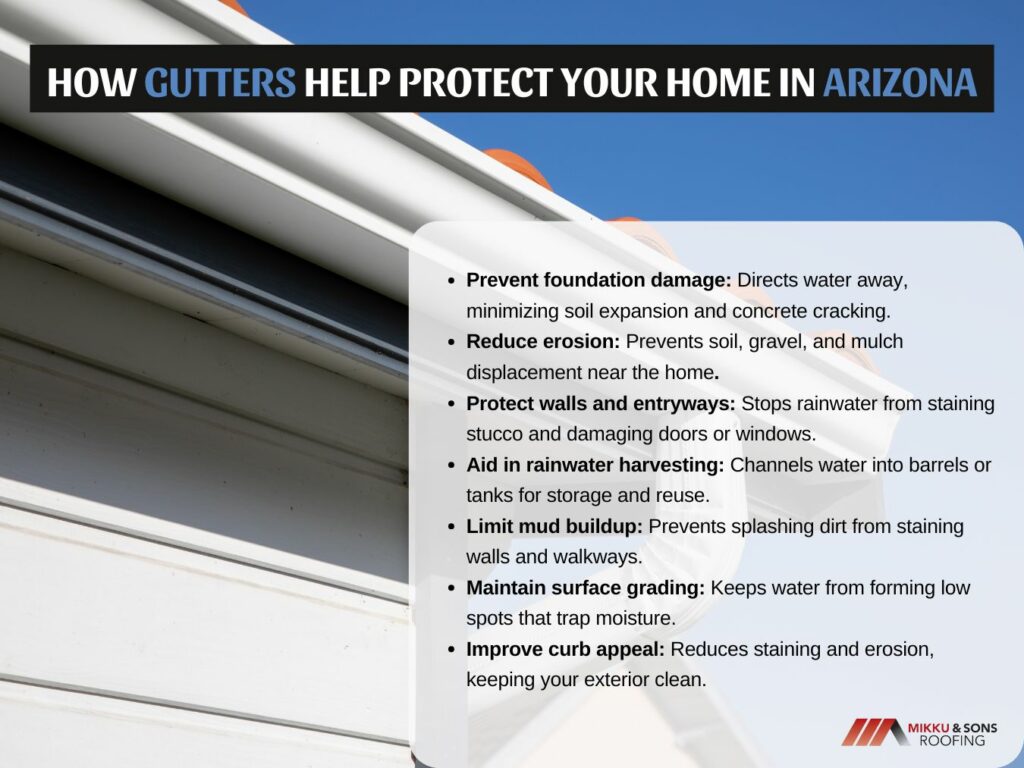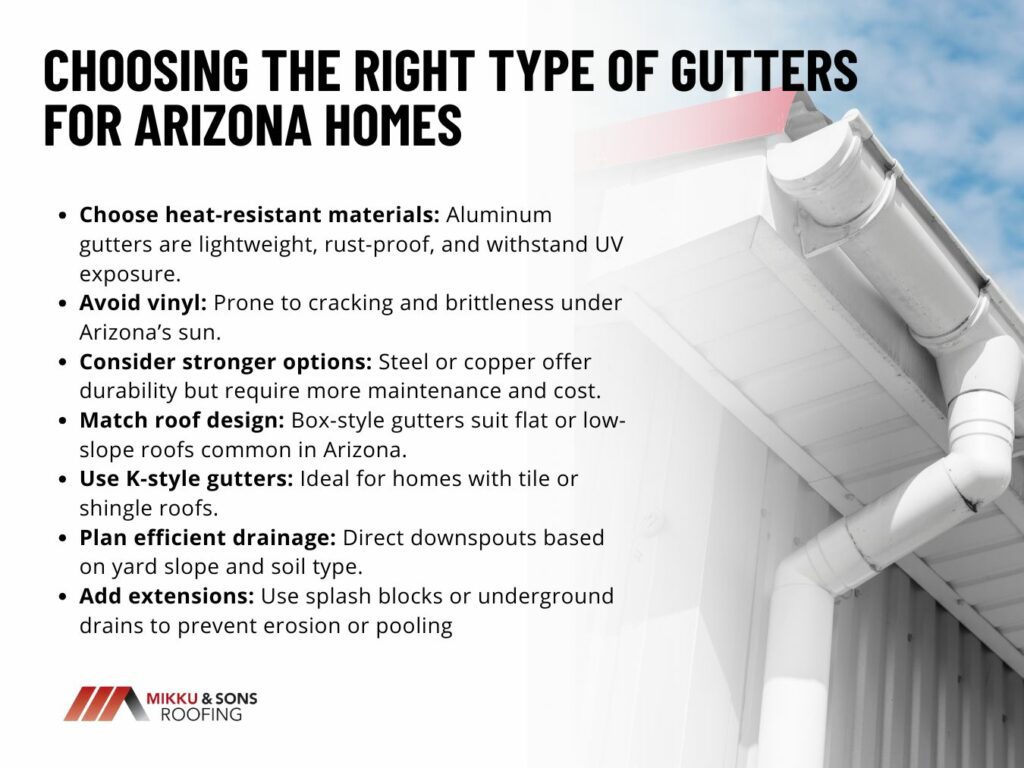

Arizona’s dry desert landscape may not seem like a place where rain gutters are necessary. With its long, hot summers and clear skies most of the year, many homeowners assume water runoff isn't a serious concern.
Monsoon season brings short but intense bursts of rainfall that can create real problems for homes not equipped to handle it. Arizona homes are designed to handle the sun and heat, with stucco exteriors and tile roofs.
However, when water hits those surfaces without a clear path to drain, it begins to wear away at what should be long-lasting protection. Uncontrolled rainwater can find its way into tiny cracks, settle around the foundation, or run directly into low-lying areas, eroding soil and staining walls. Why do you need gutters on your house in Arizona? Let's find out.

Rain gutters are part of a system designed to redirect water and reduce structural strain during storms. Homes without a means to manage runoff often show signs of early wear near the base, corners, and along exterior walls.
Although roofs are designed to shed water, without gutters, that runoff has no specific exit route. Water spills over, pools in unintended areas, and gradually causes damage.
A well-installed gutter system can carry rainwater away from the home’s base, keeping moisture from collecting around footings and slab edges. This helps limit soil movement beneath the home, especially where expansive soils exist.
Arizona’s clay-rich ground often responds to water by swelling or shrinking, depending on moisture content. Consistent exposure to runoff increases that fluctuation, which may eventually affect the levelness of flooring or cause small but costly foundation cracks.
The weight and force of runoff from even a single storm can quickly alter the landscape near the home if there is no proper system in place.
Exterior materials are built to withstand heat, wind, and dust, but water exposure shortens their effective lifespan. In homes without gutters, repeated rainwater contact along the walls often leads to staining, surface discoloration, and material breakdown.
Stucco and paint, especially in shaded or north-facing areas, are more likely to retain moisture if runoff continues to hit them directly. Over time, this can contribute to mold and mildew growth on outer walls.
Gutters reduce this risk by keeping water off siding and away from features like window sills, door frames, and walkways. The presence of a clean drainage path also helps protect surrounding patios and paved areas from surface wear caused by unchanneled flows.
Arizona homes face a unique set of environmental pressures, especially during the monsoon season. While the region doesn’t see regular rainfall throughout the year, the bursts of intense weather that do occur can create lasting problems for buildings without proper runoff control.
Gutters function as a protective barrier by redirecting water and keeping critical parts of the home dry and stable.

Foundations are most vulnerable when water gathers directly around their edges. Repeated exposure to moisture, even over short periods, can affect the integrity of concrete footings and slabs.
In Arizona, many homes are built on expansive soils, which react strongly to changes in moisture. Water that collects too close to the structure may trigger soil movement, which leads to cracks, misaligned door frames, or uneven flooring.
A gutter system diverts that water, often into splash blocks or underground drains that lead toward safer areas of the yard. This spacing helps keep the soil near the foundation more stable throughout the year, reducing the chance of movement caused by moisture cycles.
Homes with hardscaping or shallow landscaping beds are especially prone to erosion when water is not directed away. With no gutters in place, rainwater falls heavily near the edge of the roof and hits the ground in concentrated streams.
This repeated impact displaces gravel, soil, mulch, and loose concrete over time. In some cases, exposed edges become visibly worn or undermined, creating small trenches that grow with each storm.
Erosion also reduces the effectiveness of surface grading, which is meant to angle water away from the home. When soil is washed out near the base, it can create low spots that trap water instead of moving it..
Arizona homes are often finished with stucco, painted block, or other porous materials that can stain when exposed to mineral-heavy rain. Without gutters, water falls directly down the sides of the house, carrying dust, roofing debris, and minerals that stick to the surface.
This creates visible streaks over time, especially around entry points like doors, garage frames, or large window panes. Gutters keep this water off the wall by redirecting it to controlled downspout exits, which means fewer marks and less chance for long-term moisture absorption.
This is especially helpful in shaded areas or recessed corners where air circulation is limited. Entryways that stay dry also reduce the chance of wood swelling, rusting of metal fixtures, and the slow breakdown of door seals.
With a proper gutter system in place, it becomes easier to add rainwater harvesting components, which are encouraged in many Arizona municipalities. Storage tanks, barrels, or collection basins can be connected directly to downspouts, allowing homeowners to save water during each storm.
In desert climates, even a few hundred gallons of stored rainwater make a difference. These systems can be as simple or advanced as needed, and gutters act as the first step in ensuring clean, direct flow into them.
When water enters the system from a controlled source, debris is reduced, and efficiency improves.
Homes built close to the ground are prone to splashing and dust accumulation during a storm. Without gutters, rain hits the roof and falls directly along the home’s edge, stirring up dirt and mud that sticks to stucco, siding, or concrete.
This type of buildup is especially common in Arizona’s desert zones where loose sand or fine gravel surrounds much of the structure. Redirecting water away from the base of the house helps limit this mess and makes outdoor maintenance easier.
In addition, by preventing mud from splashing onto stucco or brick, gutters help reduce long-term staining that can require pressure washing or repainting.
Local climate, building design, and environmental exposure all influence how a gutter system performs. Arizona’s weather poses unique challenges, including high heat, seasonal dust, and occasional downpours.
A good system should resist corrosion, maintain its shape under temperature swings, and remain effective during sudden weather events. Before installation, it helps to consider how these systems interact with the structure and surrounding ground features.

Arizona homes are regularly exposed to intense sunlight and high surface temperatures. Standard materials can warp, crack, or fade when exposed for extended periods without adequate resistance.
Gutters made from aluminum are a common choice because they are lightweight, rust-resistant, and can withstand high heat without significant expansion. They also tolerate dust accumulation and do not corrode easily in dry air.
Other options like steel or copper offer greater strength but come at a higher cost and may require additional maintenance to retain appearance. Vinyl gutters are often avoided in this region due to their tendency to become brittle under long-term UV exposure.
Arizona homes often feature flat or low-slope roofs that collect and release water differently than steep-pitched roofs. Gutter systems must account for how water flows off these surfaces and how quickly it needs to be moved away.
Downspouts must be planned according to how the lot is graded and where water should be directed. In areas with desert landscaping, a gentle slope and ground-level exit may be enough. In more developed lots, it may be necessary to install splash blocks or buried extensions to move water toward a drainage zone or collection area.
Many Arizona homeowners only recognize the need for gutters after spotting early signs of wear or drainage failure. These indicators typically point to larger problems developing beneath the surface.
Sometimes a home was built without gutters, while in other cases, the existing system may be undersized, clogged, or poorly placed..
One of the most obvious signs that a gutter system is lacking or failing is visible pooling around the base of the home after a storm. Water that gathers too close to the foundation can seep into cracks, create damp spots, or lead to soil movement that causes uneven settling.
These pools often form at corners or beneath eaves where runoff falls in a concentrated stream. If puddles remain long after the rain has passed, or if the soil near the home appears unusually soft or sunken, it may indicate poor drainage.
In clay-heavy soil, this can become more problematic as moisture causes expansion and contraction that exerts uneven pressure on the home’s foundation. Long-term exposure to this cycle can lead to foundation cracks and the need for structural adjustment.
Soil cracks that appear along the perimeter of a home are often caused by dry expansion followed by sudden saturation. Arizona’s soil tends to harden during dry months, then quickly shift when it absorbs moisture during storms.
Without gutters, the soil near the home experiences more abrupt changes in moisture content, especially if water runs off the roofline unchecked. This can result in uneven settling, visible gaps between walkways and the soil beneath them, or a noticeable lean in fencing and edging structures.
Over time, even patios and driveways may shift slightly if repeated runoff causes erosion at their edges.
Exterior walls should remain clean and dry after a storm, but when gutters are absent or blocked, water tends to run down the sides of the home. This often leads to visible water marks or mineral staining, particularly on stucco or other porous finishes. These vertical streaks are more than just cosmetic issues.
In some cases, the affected areas may begin to show early signs of wear, including hairline cracks or fading in paint finishes. When paired with mud splatter or debris accumulation near the bottom of the wall, this kind of staining is a reliable sign that water flow needs to be redirected.
Gutters can help keep walls clean, maintain surface coatings, and reduce the chance of long-term damage caused by trapped moisture.
Gutters serve a daily function and provide protection when conditions shift without much warning. Homes without them may appear unaffected during dry months, yet they often show gradual signs of strain as time goes on.
Even systems that are already in place can become liabilities when neglected. Gutters that are misaligned, undersized, or clogged can cause as much harm as having none at all.
Water overflowing from blocked gutters tends to pour over the sides, concentrating force along the foundation and walls. This creates the very problems a gutter system is supposed to prevent and when ignored,they can compromise that system.
